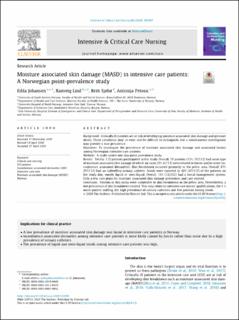Moisture associated skin damage (MASD) in intensive care patients: A Norwegian point-prevalence study
Peer reviewed, Journal article
Published version
Permanent lenke
https://hdl.handle.net/11250/2722413Utgivelsesdato
2020Metadata
Vis full innførselSamlinger
Originalversjon
Johansen, E., Lind, R., Sjøbø, B. & Petosic, A. (2020). Moisture associated skin damage (MASD) in intensive care patients: A Norwegian point-prevalence study. Intensive and Critical Care Nursing, 60, 102889. https://doi.org/10.1016/j.iccn.2020.102889Sammendrag
Background: Critically ill patients are at risk of developing moisture associated skin damage and pressure ulcers. These conditions may co-exist and be difficult to distinguish, but a simultaneous investigation may provide a true prevalence.
Objectives: To investigate the prevalence of moisture associated skin damage and associated factors among Norwegian intensive care patients.
Methods: A multi-centre one-day point-prevalence study.
Results: Totally, 112 patients participated in the study. Overall, 15 patients (13%, 15/112) had some type of moisture associated skin damage of which six cases (5%, 6/112) were related to faeces and/or urine (incontinence associated dermatitis). Skin breakdown occurred primarily in the pelvic area. Overall, 87% (97/112) had an indwelling urinary catheter. Stools were reported in 42% (47/112) of the patients on the study day, mostly liquid or semi-liquid. Overall, 11% (12/112) had a faecal management system. Only a few care plans for moisture associated skin damage prevention and care existed.
Conclusion: Patients in this study were vulnerable to skin breakdown in the pelvic area. Nevertheless, a low prevalence of skin breakdown existed. This may relate to intensive care nurses’ qualifications, the 1:1 nurse-patient staffing, the high prevalence of urinary catheters and few patients having stools.

